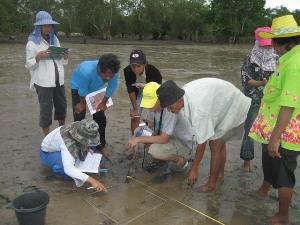Barry Bendell
Other projects
22 Mar 2012
Evaluation and Monitoring of Marine Protected Areas in Seagrass Meadows at Phra Thong Island,Thailand
18 Oct 2016
An Alternative Approach for the Conservation and Farming of the Endangered Sea Cucumber Holothuria scabra
This project aims to document the status of the seagrass resource at Phra Thong Island, increase local awareness of the benefits of conserving it, and develop a community-based program to monitor the long-term viability of the meadows.

Monitoring.
Seagrass meadows are a vital fisheries resource for coastal communities such as those on Phra Thong Island in Thailand They are an important source of fish, molluscs, crustaceans, and sea cucumbers for local fishers, and are a nursery habitat for juvenile fish. They are also an important wildlife habitat. Seagrasses are food for green turtles and dugongs, both of which are endangered locally, and have been the target of major conservation efforts regionally.

A view of meadow at low tide.
This project aims to document the seagrass resources at Phra Thong Island, increase local awareness of the benefits of conserving the habitat, and develop a community-based program to monitor the long-term viability of the meadows around the island. The project site is near Lion village, which was built to replace another village completely destroyed by the Asian tsunami of 26 December 2004. The local community has since been working with NGOs, Mangrove Action Project (MAP) and Naucrates, to promote community-based management of coastal resources and environmental education. Seagrass meadows near the village provide a rich harvest of rabbitfish and groupers, and many invertebrate animals, such as conch, sea cucumber and crab. The project will map those meadows to provide a basis for any future regulation or zoning of the exploitation of those resources.
Educational materials will be developed for the local resource centre, and for use in a community eco-tourism project. Seagrass monitoring sites have already been established near the village, and will be monitored at three-month intervals through the year. Community members will be trained in monitoring using the general procedures of the Seagrass-Watch Program, which will be adapted to meet local conditions. Participants will learn to identify seagrass species, estimate their percent coverage in quadrats, and record other relevant information from fixed plots. It is expected that a group of community members will develop with the knowledge and skills for the long-term monitoring of seagrass meadows beyond the time of the project, and that the increased knowledge and awareness of the seagrass habitat will lead to the development of management planning for its sustainable use and conservation.